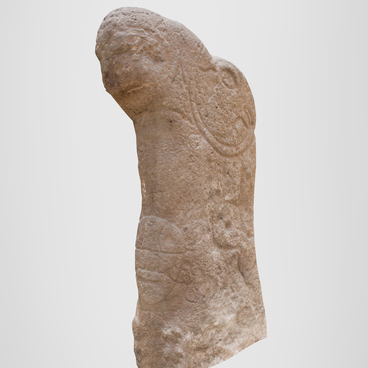The display features a slab of red sandstone with engraved drawings of horses. Initially, it was part of the stone fence of a mound of the Scythian time. Archaeologists date the mound to the 7th-2nd century BC. It was found on the territory of the “Engels” collective farm in the Askiz district of the Republic of Khakassia.
In the middle of the 20th century, the slab was transported to the Khakass Museum of Local History. It depicts the figures of three horses. The drawing was made using the technique of pecking with subsequent grinding of the lines. The image was taken between the 1st century BC and the 5th century AD — it refers to the Tashtyk archaeological culture. This is the name of the culture of Southern Siberia in the Iron Age. It is the successor of the Tagar culture, but differs fundamentally from it in its use of iron. During this period, the main occupations were agriculture and cattle breeding, including horse breeding.
In the center of the composition is the most detailed and largest profile image of a running horse. On the rump of the animal, you can see the Khakass ethnographic tamga — the personal mark of the cattle breeder. Such schematic images served as a substitute for the signature on the document. Some researchers consider tamga to be the prototype of the family coat of arms: each family had its own sign.
The second horse is depicted on the left side of the slab, just below the central figure. This image is not made as carefully as the first one: it is embossed with dots, and the lines are not polished. The image of the horse’s rump was damaged by a later pecking, the origin of which could not be established by archaeologists.
The third drawing is on the right side of the slab; it has survived only partially, since part of the stone was lost — along with the image of the head and a foreleg of the horse.
On the right side of the slab, just below the image of the third horse, there are two schematic drawings of male figures. One of them is also damaged due to the destruction of the stone. Two more groups of embossed drawings are found below and above the image of a group of horses, in the central part of the slab. The story behind these scenes and even the approximate time when they were made has not been established.
In the middle of the 20th century, the slab was transported to the Khakass Museum of Local History. It depicts the figures of three horses. The drawing was made using the technique of pecking with subsequent grinding of the lines. The image was taken between the 1st century BC and the 5th century AD — it refers to the Tashtyk archaeological culture. This is the name of the culture of Southern Siberia in the Iron Age. It is the successor of the Tagar culture, but differs fundamentally from it in its use of iron. During this period, the main occupations were agriculture and cattle breeding, including horse breeding.
In the center of the composition is the most detailed and largest profile image of a running horse. On the rump of the animal, you can see the Khakass ethnographic tamga — the personal mark of the cattle breeder. Such schematic images served as a substitute for the signature on the document. Some researchers consider tamga to be the prototype of the family coat of arms: each family had its own sign.
The second horse is depicted on the left side of the slab, just below the central figure. This image is not made as carefully as the first one: it is embossed with dots, and the lines are not polished. The image of the horse’s rump was damaged by a later pecking, the origin of which could not be established by archaeologists.
The third drawing is on the right side of the slab; it has survived only partially, since part of the stone was lost — along with the image of the head and a foreleg of the horse.
On the right side of the slab, just below the image of the third horse, there are two schematic drawings of male figures. One of them is also damaged due to the destruction of the stone. Two more groups of embossed drawings are found below and above the image of a group of horses, in the central part of the slab. The story behind these scenes and even the approximate time when they were made has not been established.



